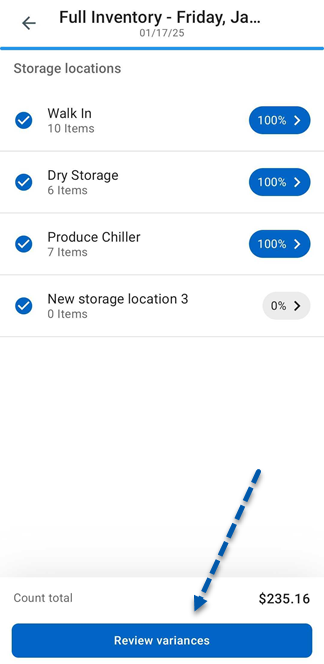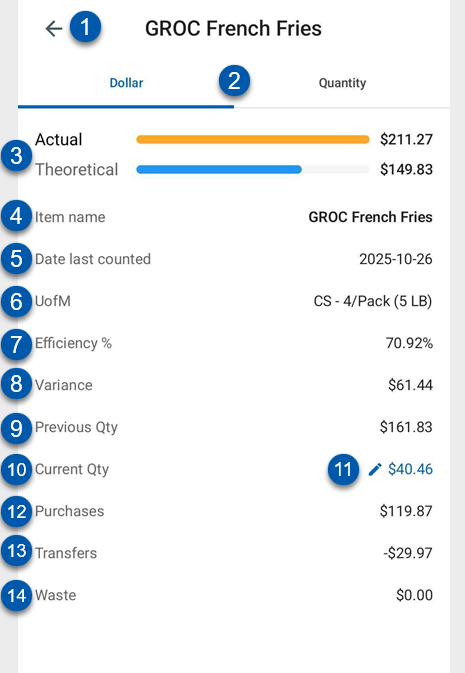The Theoretical Variance Review screen lists all counted items with their actual and theoretical quantities. It is used to review and resolve discrepancies before completing the inventory count.
From this screen, users can:
View all counted items and their variance details
Filter or sort the list to focus on specific variances
Review items flagged as violations
Open item details to confirm or adjust quantities
Security
Users must have the following permission to access the Theoretical Variance Review screen:
Food → Inventory Counts → View Inventory Counts → View Variance Tab
These permissions can be added to custom user roles or individual users. The Permission Access report can be used to determine which user roles or users already have these permissions assigned. For more information, see User Setup and Security.
Navigation
On the Inventory Count screen, tap Review Variances.

The Review Variances button is disabled for users without the View Variance Tab permission.
Theoretical Variance Review Screen Buttons and Fields

Button/Field | Description | |
|---|---|---|
1 | Back | Returns to the Inventory Count screen. |
2 | Search | Searches the item list for entered text. |
3 | Filter | Opens the filter menu with the following options:
Sort
Template
|
4 | Quick Filters | Filters the item list to show either all items or all items with variance violations. |
5 | Quantity Toggle | Switches the values between dollar and item quantity. |
6 | Item Summary | Variance summary for a single item within the count. Tap to open its item details. |
7 | Item Name | Name of the item counted. |
8 | UofM | Unit of measure used to count the item. |
9 | Actual Bar | Shows the actual usage of the item in dollars or in quantity.
|
10 | Theoretical Bar | Shows the theoretical usage of the item in dollars or in quantity. |
11 | Violation Notice | Indicates that the item has a variance threshold violation. |
12 | Variance Percentage/ Efficiency % | The efficiency percent. This is the calculation of theoretical cost divided by the actual cost of the item.
|
13 | Complete | Marks the inventory count as complete.
|
Item Variance Details Screen
When an item is tapped, the item variance details appear.

Button/Field | Description | |
|---|---|---|
1 | Back | Returns to the Theoretical Variance Review screen. |
2 | Dollar / Quantity Tabs | Switches between dollar view or quantity view. |
3 | Actual / Theoretical Bars | The actual and theoretical usage of the item in either dollars or quantity.
|
4 | Item Name | Name of the item counted. |
5 | Date Last Counted | The last time this item was counted. |
6 | UofM | Unit of measure used to count the selected item. |
7 | Efficiency % | The efficiency percent. This is the calculation of theoretical cost divided by the actual cost of the item.
|
8 | Variance | The variance between the theoretical and actual usage. This is the actual usage minus the theoretical usage. |
9 | Previous Qty | Quantity of the item counted on the last inventory count. |
10 | Current Qty | Quantity of the item entered on the current inventory count. |
11 | Edit Entry | Tap to manually update counts for all storage locations and units of measure. |
12 | Purchases | The cost or quantity of the item purchased between the last count and the current count. |
13 | Transfers | The cost or quantity of the item transferred in or out of the store between the last count and the current count. |
14 | Waste | The cost or quantity of the item logged as waste between the last count and the current count. |